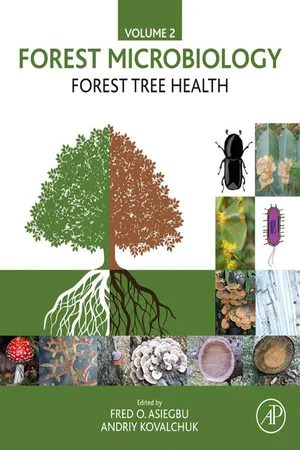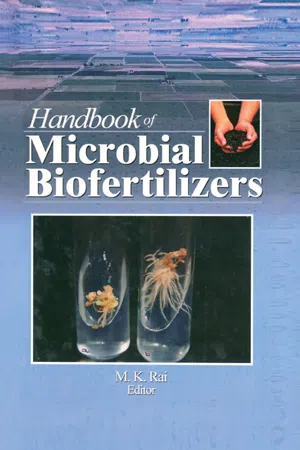Biological Sciences
Armillaria
Armillaria is a genus of fungi that includes several species known as honey fungi. These fungi are parasitic and can cause root rot in trees and woody plants. They are also known for their ability to form large, long-lived colonies, making them important in forest ecology and as a model for studying fungal genetics and evolution.
Written by Perlego with AI-assistance
Related key terms
1 of 5
4 Key excerpts on "Armillaria"
- eBook - ePub
Forest Microbiology
Volume 2: Forest Tree Health
- Fred O Asiegbu, Andriy Kovalchuk(Authors)
- 2022(Publication Date)
- Academic Press(Publisher)
Parsons et al., 2003 ).Armillaria has some interesting, but disparate, features related to its ecological functions. For example, Armillaria is known for its bioluminescence, which is the subject of many hypotheses, but the ecological function of this property remains largely unverified (e.g., Baumgartner et al., 2011 ; Mihail, 2015 ). In eastern Asia, Armillaria spp. can form unique mycorrhizal relationships with achlorophyllous, mycoheterotrophic orchids, such as Galeola, Gastrodia, and Cyrtosia, which contain species that are important in traditional medicine (e.g., Baumgartner et al., 2011 ; Guo et al., 2016 ; Suetsugu et al., 2020 ). In other situations, Armillaria can participate in symbioses with other fungi, where it can serve as the host (e.g., Entoloma abortivum) or parasite (e.g., Wynnea) (Baumgartner et al., 2011 ). As mentioned previously, Armillaria can display very long-term and wide-spread occupancy of a site (e.g., Smith et al., 1992 ; Ferguson et al., 2003 ).6: Interactions between Armillaria and insects
Armillaria and insects typically co-occur and exhibit strong interactions that are often difficult to interpret (Kedves et al., 2021 ). In some geographic areas, such as the western USA, Armillaria infections are associated with predisposing conifers to attack by bark beetles, such as mountain pine beetle (Dendroctonus ponderosae) and western balsam bark beetle (Dryocoetes confusus) (e.g., Hertert et al., 1975 ; Kulhavy et al., 1984 ; Tkacz and Schmitz, 1986 ; Lalande et al., 2020 ; Sierota and Grodzki, 2020 ). Further evidence suggests that Armillaria infection of spruce (Picea) can induce the production of volatile compounds that attract bark beetles, such as engraver beetles (Ips spp.) (Madziara-Borusiewicz and Strzelecka, 1977 ; Sierota and Grodzki, 2020 ). Because both Armillaria and bark beetles tend to attack stressed trees, interactions among Armillaria - eBook - ePub
Mushrooms
Nutraceuticals and Functional Foods
- Deepu Pandita, Anu Pandita, Deepu Pandita, Anu Pandita(Authors)
- 2023(Publication Date)
- CRC Press(Publisher)
Armillaria mellea, to degrade waste present in the environment. This area of research has not been thoroughly investigated yet and has a great potential to become a global phenomenon for combating environmental pollution.10. Current and Future Developments
Armillaria mellea remains to be fully investigated, but present-day data indicate that Armillaria mellea is an unmatched organism for developing anticonvulsants as well as for discovering novel biologically-active compounds. The therapeutic components of Gastrodia elata host were majorly Armillaria catabolites and anabolites. A plausible scenario is that there is an exchange of DNA amongst the symbiont and host that leads to the production of a few commonly present metabolites throughout evolution. A need for genetic examination is present to unveil the mystery of mutualistic relationships amongst Armillaria and Gastrodia elata. The fungus Armillaria mellea is not cultivated in fields as its mycelia may lead to the spoilage of some plant roots (Aguín et al., 2006 ). Biotechnology is a practical solution to produce the biologically active compounds present in Armillaria mellea in large quantities as it allows optimising and improving the fungal strains. Bioreactor culture is crucial for producing bulk quantities of Armillaria mellea and furthering its scope on an industrial scale. Compounds derived from Armillaria mellea offer new windows for immunostimulant and antiepileptic therapies along with other medicinal uses. These compounds have to be further evaluated in the context of structure and mechanism of action.References
- Aguín, O., Mansilla, J.P. and Sainz, M.J. (2006). In vitro selection of an effective fungicide against Armillaria mellea and control of white root rot of grapevine in the field. Pest Manage. Sci ., 62: 223–228.
- Arnone, A., Cardillo, R. and Nasini, G. (1986). Structures of melleolides B-D three antibacterial sesquiterpenoids from Armillaria mellea
- eBook - PDF
- Mahendra Rai(Author)
- 2006(Publication Date)
- CRC Press(Publisher)
The use of microorganisms, such as mycorrhizal fungi, and of biological processes that occur in the soil constitute one of the strategies of sustainable agricul-ture, where there is a need to guarantee higher yield with reduction of the use of fertilizers that are risky to the environment and that increase costs (Siqueira and Franco, 1998). In this context, the biotechnological potential of the mycorrhizal association is evident, mainly by the impact that it can have in both levels: agricultural (increasing plant production) and environ-mental (promoting better quality of the ecosystems). CONCLUSIONS The behavior of mycorrhizal plants in regard to root pathogens is com-plex, being affected by diverse factors, including the density of inoculum of the pathogen, the species of AMF associated to the plant, and the levels of nutrients in the soil. There are indications that formation of mycorrhizae will induce plant resistance when the plant is challenged by a pathogen. The evidences show that mycorrhiza formation helps the host to suppress patho-gens by several means, and it is probably a combination of mechanisms which respond. On the other hand, a better understanding of the relations of Interaction Between Arbuscular Mycorrhizal Fungi and Root Pathogens 341 AMF-host-pathogen-environment, as well as the most appropriate, fast, and efficient way to inhibit/suppress the plant pathogenic agent, are objectives that are still being pursued. Research should be directed to clarify the still unclear key points of the pathogen ´ host ´ mycorrhizal fungus relation-ship, under diverse environmental conditions, in order to avoid establish-ment of plant pathogens, and get the benefits from mycorrhization. It seems a general agreement that studies on the molecular aspects of symbiosis are essential. The results of many experiments have shown that each system should be considered separately, and that there is no model to be universally adopted. - Katti, Gururaj(Authors)
- 2018(Publication Date)
- Daya Publishing House(Publisher)
Further mycorhizosphere supports higher population of antagonists and siderophore producers. Thus the possibility of biologically controlling the root pathogens with AMF looks promising. Keywords: AM fungi, Biocontrol, Soil-borne plant pathogens. Introduction Plant roots provide an ecological niche for many of the microorganisms that abound in soil. German botanist Albert Bernard Frank in 1885 introduced the Greek word 'mycorrhiza' which literally means fungus root. Most plant roots form mycorrhizal associations of one kind or the other with certain fungi in soil. These mycorrhizal fungi perform the function of root hairs. The symbiosis is so well balanced that, although many of the host cells are invaded by the fungal endophytes there is neither visible tissue damage nor low degree of pathogenicity towards its host. Mycorrhizal association generally enhances the growth and vigour of the host plants. Because of their wide spread occurrence in nature and their numerous benefits to plants, these fungi are currently attracting much attention in agricultural, horticultural and forestry research. Though there are different mycorrhizal associations, the most common type occurring in all ecological situations, especially in tropics, is the arbuscular mycorrhiza (AM) (Bagyaraj, 2006). Arbuscular mycorrhiza are geographically ubiquitous and occur over a broad ecological range. They are commonly found in association with agricultural crops, most shrubs, most tropical tree species and some temperate tree species. AM has been observed in 1000 genera of plants representing some 200 families. There are atleast 300,000 respective hosts in the world flora and around 230 species of AM fungi (Bagyaraj, 2011). AM fungi belong to the phylum Glomeromycota, which has a single class Glomeromycetes with four orders Glomerales, Diversisporales, Paraglomerales and Archaeosporales. There are 11 families, 17 genera and This ebook is exclusively for this university only.
Index pages curate the most relevant extracts from our library of academic textbooks. They’ve been created using an in-house natural language model (NLM), each adding context and meaning to key research topics.



